Las Vegas may be known for its glittering casinos, world-class entertainment, and bustling nightlife, but beyond the neon lights lies a world teeming with natural beauty and wildlife. For locals and visitors looking to escape the Strip and reconnect with nature, there are numerous locations just a short drive away where diverse ecosystems thrive. The best places to spot wildlife near Las Vegas offer everything from rugged desert landscapes to lush wetlands, providing habitats for a variety of creatures. Whether you’re an avid birdwatcher, a casual hiker, or a nature photographer, the surrounding areas of Las Vegas hold hidden gems that allow you to experience Nevada’s untamed side.
In this article, we’ll explore some of the most remarkable wildlife-watching destinations near Las Vegas, providing insights into what you can expect, the best times to visit, and the unique species you might encounter.
Red Rock Canyon National Conservation Area
Red Rock Canyon is one of the most popular nature destinations for Las Vegas locals and tourists alike. Located just 17 miles west of the city, this conservation area is famed for its dramatic red sandstone formations, diverse hiking trails, and abundant wildlife.
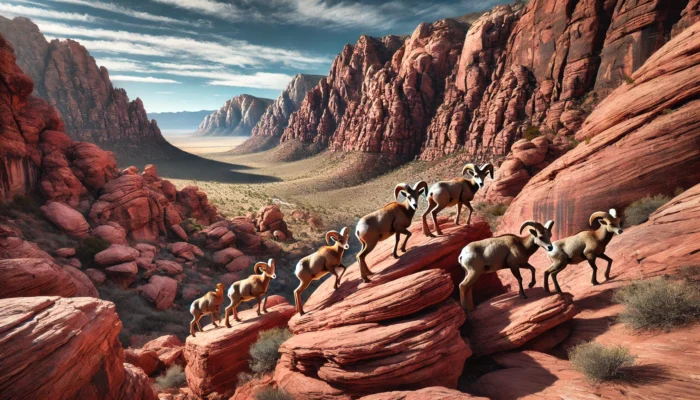
Wildlife You Can See
- Desert Bighorn Sheep – Often spotted on high ridges or steep cliffs, these agile climbers are Nevada’s state animal.
- Coyotes – Frequently seen during early morning or late evening, these adaptable predators roam the desert in search of food.
- Chuckwallas – Large desert lizards that bask on warm rocks during the day.
- Red-tailed Hawks – Commonly seen soaring above the canyon in search of prey.
- Tarantulas – More active during the late summer and fall, tarantulas are harmless and often cross the paths of hikers.
Best Trails for Wildlife Spotting
- Calico Tanks Trail – Offers panoramic views and frequent wildlife sightings.
- Moenkopi Loop – Ideal for seeing desert flora and fauna up close.
- Ice Box Canyon – Provides cooler temperatures and an excellent chance to spot unique birds.
Best Time to Visit
- Spring and Fall – Cooler temperatures and increased animal activity.
- Early Morning or Dusk – Wildlife is more active during these times, avoiding the heat of the midday sun.
Valley of Fire State Park
Located about 50 miles northeast of Las Vegas, Valley of Fire State Park boasts striking red rock formations and is Nevada’s oldest state park. This area is known for its ancient petroglyphs and unique geological features, but it is also home to a variety of desert wildlife.
Wildlife You Can See
- Desert Tortoises – Rare but occasionally seen, particularly in the spring and after rainfall.
- Kit Foxes – Elusive and nocturnal, kit foxes inhabit the park’s quieter areas.
- White-tailed Antelope Squirrels – Frequently seen darting across trails.
- Gila Monsters – Venomous but reclusive, these lizards are more likely to be spotted in spring.
- Ravens – Intelligent and often observed around campgrounds and parking areas.
Best Trails for Wildlife Spotting
- Mouse’s Tank Trail – A relatively easy hike with frequent wildlife sightings.
- Fire Wave Trail – Offers scenic views and chances to encounter small mammals and reptiles.
- White Domes Trail – Provides diverse terrain and wildlife encounters.
Best Time to Visit
- October through April – Cooler weather and increased chances of seeing wildlife.
- Early Morning – Best for birdwatching and spotting mammals before they retreat to shaded areas.
Spring Mountains National Recreation Area
Known locally as Mount Charleston, the Spring Mountains are a refreshing retreat from the Las Vegas heat. Just 40 minutes northwest of the city, the area features pine forests, alpine meadows, and snow-capped peaks in winter. This diverse habitat supports a unique array of wildlife.
Wildlife You Can See
- Mule Deer – Frequently seen grazing in meadows or near campgrounds.
- Mountain Lions – Rarely seen but present in the area.
- Pygmy Nuthatches – Tiny birds that are often seen hopping along tree trunks.
- Western Bluebirds – Known for their vibrant colors, they are common in forested areas.
- Gray Foxes – Occasionally spotted during dusk or dawn.
Best Trails for Wildlife Spotting
- Cathedral Rock Trail – Popular for deer sightings and birdwatching.
- Mary Jane Falls – A moderate trail with shaded areas ideal for encountering wildlife.
- Bristlecone Trail – Passes through a variety of ecosystems and increases chances of wildlife sightings.
Best Time to Visit
- Summer – A cooler alternative to the valley’s heat.
- Fall and Spring – Ideal for observing wildlife during transitional seasons.
Lake Mead National Recreation Area
Lake Mead, about 30 miles southeast of Las Vegas, is the largest reservoir in the United States. The area is known not only for recreational water activities but also for its rich wildlife diversity along the shoreline and in the surrounding desert.
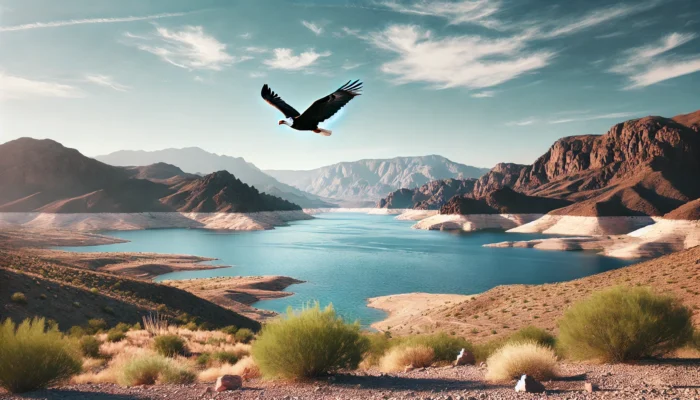
Wildlife You Can See
- Desert Bighorn Sheep – Often found near water sources.
- Bald Eagles – Seen during the winter months.
- Ospreys – Commonly seen fishing in the lake.
- Roadrunners – Frequently spotted darting across desert trails.
- Jackrabbits – Abundant in desert scrub areas.
Best Trails for Wildlife Spotting
- Historic Railroad Trail – Offers views of the lake and good chances to see bighorn sheep.
- River Mountains Loop Trail – Great for birdwatching and small mammals.
- Bowl of Fire – A lesser-known area with abundant wildlife.
Best Time to Visit
- Late Fall through Early Spring – Pleasant weather and active wildlife.
- Sunrise and Sunset – Best for animal activity and photography.
Clark County Wetlands Park
For those who don’t want to venture far, Clark County Wetlands Park lies just minutes from downtown Las Vegas. This park protects a lush riparian environment and provides a critical habitat for numerous bird species and other wildlife.
Wildlife You Can See
- Great Blue Herons – Commonly seen along the water’s edge.
- Turtles – Frequently seen basking in the sun.
- Cottontail Rabbits – Abundant along trails.
- American Coots – Common in the park’s ponds.
- Hummingbirds – Attracted to flowering plants in the park.
Best Trails for Wildlife Spotting
- Duck Creek Trail – Easy and offers views of wetland wildlife.
- Nature Preserve Trail – A prime location for birdwatching.
- Coyote Trail – Known for sightings of small mammals and birds.
Best Time to Visit
- Year-round – Wildlife is present throughout the year.
- Early Morning – Best for birdwatching and peaceful walks.
Sloan Canyon National Conservation Area
Located just 30 minutes south of Las Vegas, Sloan Canyon is a hidden gem that combines cultural history with desert wildlife. Known for its ancient petroglyphs, the area also supports various desert species. With fewer crowds than Red Rock Canyon, it offers a quieter, more intimate wildlife experience.
Wildlife You Can See
- Desert Bighorn Sheep – Often seen navigating the rocky cliffs.
- Coyotes – Frequently spotted during early morning hikes.
- Gila Monsters – Occasionally found in the warmer months.
- Golden Eagles – Known to nest in the canyon’s cliffs.
- Spotted Lizards – Common along sunlit rocks and trails.
Best Trails for Wildlife Spotting
- Petroglyph Canyon Trail – Known for its archaeological significance and wildlife sightings.
- Anthem East Trailhead – Offers elevated views and the chance to spot bighorn sheep.
Best Time to Visit
- Spring and Fall – Cooler weather encourages more animal activity.
- Early Morning – Ideal for quiet hikes and increased chances of seeing animals.
Pahranagat National Wildlife Refuge
Approximately 90 minutes north of Las Vegas, Pahranagat National Wildlife Refuge provides a striking contrast to the surrounding desert. This lush wetland area is part of the Pacific Flyway, attracting thousands of migratory birds throughout the year.
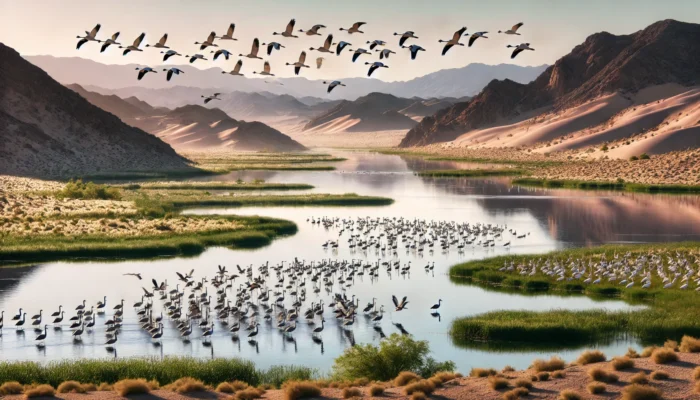
Wildlife You Can See
- Bald Eagles – Common in winter months around the lakes.
- Great Egrets – Seen stalking fish in shallow waters.
- Beavers – Look for their lodges and dams along the waterways.
- Bobcats – Occasionally spotted near wooded areas.
- Pelicans – Large flocks can be seen during migration periods.
Best Trails for Wildlife Spotting
- Upper Lake Trail – Winds along the water, providing excellent birdwatching opportunities.
- North Marsh Loop – Passes through wetland and marsh areas, rich with diverse wildlife.
Best Time to Visit
- Spring and Fall – Peak bird migration seasons.
- Winter – Ideal for spotting bald eagles and waterfowl.
Ash Meadows National Wildlife Refuge
Located about 2 hours west of Las Vegas, Ash Meadows is one of the most biodiverse areas in the Mojave Desert. This rare desert wetland is home to endemic species found nowhere else in the world. It’s a fascinating destination for nature lovers and wildlife enthusiasts.
Wildlife You Can See
- Pupfish – These tiny, endangered fish thrive in the area’s springs.
- Cottontail Rabbits – Frequently seen along trails.
- Western Toads – Found near marshy areas and ponds.
- Roadrunners – Often seen darting across trails.
- Burrowing Owls – Known to nest in the refuge’s flat desert terrain.
Best Trails for Wildlife Spotting
- Crystal Springs Boardwalk – A short, accessible boardwalk with views of pupfish and native plants.
- Point of Rocks Trail – Offers stunning views of the wetland and frequent wildlife encounters.
Best Time to Visit
- Spring – Wildflowers bloom, and wildlife is most active.
- Fall and Winter – Cooler temperatures and increased bird activity.
Desert National Wildlife Refuge
Spanning over 1.6 million acres, the Desert National Wildlife Refuge lies just north of Las Vegas and protects critical desert habitat for countless species. The refuge’s diverse terrain ranges from sand dunes to rugged mountains, providing a variety of wildlife experiences.
Wildlife You Can See
- Mountain Lions – Rare but occasionally seen in remote areas.
- Bighorn Sheep – A common sight, especially near the higher elevations.
- Leopard Lizards – Abundant along sandy trails.
- Kangaroo Rats – Often active at night in open desert areas.
- Vermilion Flycatchers – Vibrant birds spotted near springs and riparian zones.
Best Trails for Wildlife Spotting
- Corn Creek Nature Trail – A short, shaded trail with flowing springs that attract diverse wildlife.
- Hidden Forest Trail – Leads to a historic cabin and offers opportunities to see bighorn sheep and other mountain species.
Best Time to Visit
- Spring and Fall – Cooler temperatures and greater wildlife activity.
- Early Morning or Dusk – Optimal times for viewing nocturnal and crepuscular animals.
Tule Springs Fossil Beds National Monument
Located just north of Las Vegas, Tule Springs Fossil Beds preserves Ice Age fossils alongside modern wildlife. This area offers a blend of history and nature, with trails that highlight both ancient remains and living desert species.
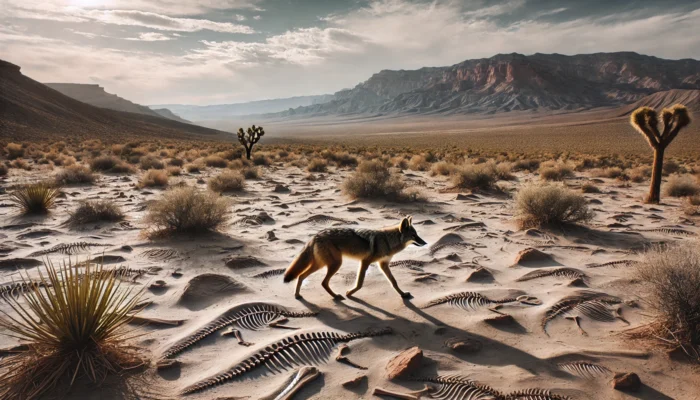
Wildlife You Can See
- Coyotes – Commonly spotted near the outskirts of the park.
- Jackrabbits – Frequently seen darting through open desert spaces.
- Burrowing Owls – Nest in the area’s sandy banks and flatlands.
- Harris’s Hawks – Sometimes seen hunting in small groups.
- Sidewinders – A species of rattlesnake that blends into the sandy terrain.
Best Trails for Wildlife Spotting
- Fossil Beds Loop – An interpretive trail that highlights both fossils and local wildlife.
- Desert Wash Trail – A remote trail with high chances of spotting desert reptiles and small mammals.
Best Time to Visit
- Fall and Spring – Comfortable temperatures and increased wildlife sightings.
- Late Afternoon – Good for catching nocturnal animals beginning to stir.
Family-Friendly Wildlife Activities
Las Vegas offers numerous opportunities for families to experience wildlife together. From easy walking trails to interactive exhibits, the region’s diverse environments provide perfect settings for introducing kids to nature and fostering a love for wildlife.
Wildlife Watching with Kids
- Clark County Wetlands Park – This expansive park is ideal for families, with flat, stroller-friendly trails and an abundance of wildlife. Turtles, rabbits, and various bird species can be seen along the paths. The Nature Center offers interactive displays about local ecosystems.
- Red Rock Canyon Visitor Center – Before heading out on a hike, stop by the visitor center where children can see live desert animals and learn about the park’s ecology through engaging exhibits.
- Mount Charleston Picnic Areas – Many picnic areas are located near meadows where mule deer frequently graze. Families can enjoy lunch while observing wildlife from a safe distance.
- Lake Mead Fish Hatchery – Located near Lake Mead, the hatchery offers a chance for kids to see fish at different stages of development and learn about the importance of aquatic wildlife conservation.
- Springs Preserve – This educational site in Las Vegas features live animal exhibits, botanical gardens, and walking trails where families can spot hummingbirds and lizards.
Kid-Friendly Trails and Paths
- Nature Preserve Loop (Wetlands Park) – A short, flat loop ideal for young kids, providing scenic views of ponds and marshes bustling with wildlife.
- Lost Creek – Children’s Discovery Trail (Red Rock Canyon) – An easy, shaded trail with seasonal waterfalls and petroglyphs, making it a fun and educational adventure for children.
- Echo Trail (Mount Charleston) – A simple, one-mile trail with gentle slopes and shaded forest areas. Look out for chipmunks, squirrels, and bluebirds.
Tips for Wildlife Viewing with Kids
- Bring Binoculars – Kids enjoy spotting animals at a distance, and binoculars enhance the experience.
- Engage Their Curiosity – Turn wildlife spotting into a game by asking children to identify different species.
- Visit Early in the Day – Mornings offer the best chance to see wildlife before animals retreat from the midday heat.
- Pack Snacks and Water – Keep the adventure fun and comfortable with plenty of refreshments.
Seasonal Wildlife Guides
Wildlife activity around Las Vegas shifts dramatically with the seasons. Knowing when to visit different areas can maximize your chances of spotting specific animals and experiencing the landscape at its best.
Spring (March to May)
- Active Desert Wildlife – Reptiles, including desert tortoises and Gila monsters, become more active as temperatures rise.
- Bird Migration – Wetlands Park and Lake Mead are prime locations to see migratory birds like herons and egrets.
- Blooming Desert – Wildflowers and cacti bloom, attracting pollinators such as hummingbirds and bees.
- Best Spots – Valley of Fire, Red Rock Canyon, Wetlands Park.
Summer (June to August)
- High-Elevation Escapes – Wildlife retreats to cooler areas, making Mount Charleston the best summer destination. Deer, foxes, and various bird species are often spotted.
- Nocturnal Activity – Many desert animals, including coyotes and owls, become more active at night. Consider evening hikes or star-gazing trips.
- Best Spots – Mount Charleston, Lee Canyon, and higher elevations of Red Rock Canyon.
Fall (September to November)
- Transition Period – Birds begin migrating south, and mammals prepare for winter. Look for desert bighorn sheep as they become more visible.
- Increased Activity – Cooler temperatures lead to increased daytime activity for animals like jackrabbits and roadrunners.
- Best Spots – Red Rock Canyon, Lake Mead, Valley of Fire.
Winter (December to February)
- Rare Bird Sightings – Bald eagles and other raptors can be spotted near Lake Mead.
- Mammals in Lowland Areas – Bighorn sheep often move to lower elevations, making them easier to spot along scenic routes.
- Snow-Capped Peaks – While Mount Charleston attracts snow recreation enthusiasts, it’s also a good time to spot mule deer.
- Best Spots – Lake Mead, Mount Charleston, and Wetlands Park.
Photography Tips for Wildlife
Photographing wildlife near Las Vegas requires patience, preparation, and a deep appreciation for the desert environment. The region’s diverse landscapes—from red rock canyons to alpine forests—offer incredible opportunities to capture stunning images of native species.
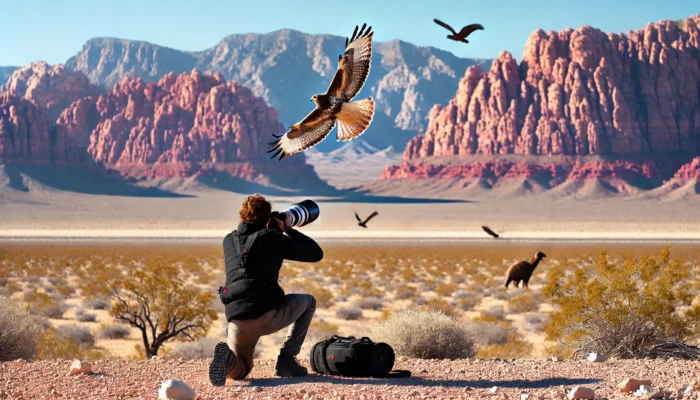
Essential Gear for Wildlife Photography
- Telephoto Lens – A 300mm or longer lens allows you to photograph animals from a distance without disturbing them.
- Tripod or Monopod – Stabilizes your camera for sharp images, especially in low-light conditions or with heavy lenses.
- Binoculars – Useful for scouting wildlife before setting up your shot.
- Neutral Clothing – Wear earth-toned or camouflaged clothing to blend into the environment and avoid startling wildlife.
Best Times for Photography
- Golden Hour – Early morning and late afternoon provide soft, warm light that enhances photos and coincides with peak wildlife activity.
- Seasonal Timing – Spring and fall offer the most vibrant wildlife activity and colors in the desert.
- After Rainfall – Desert animals are more likely to emerge after rain, and the landscape appears more vibrant.
Techniques for Capturing Stunning Wildlife Photos
- Use Silent Mode – Many cameras have silent shutter options, reducing noise that might scare off animals.
- Focus on the Eyes – Sharp eyes create engaging and emotive images.
- Shoot at Eye Level – Position your camera at the animal’s eye level to create a more intimate and powerful image.
- Incorporate the Landscape – Frame wildlife against dramatic backdrops like Red Rock Canyon’s sandstone cliffs or Lake Mead’s shimmering waters.
Best Locations for Wildlife Photography
- Red Rock Canyon – Excellent for capturing bighorn sheep, hawks, and desert scenery.
- Mount Charleston – Forested areas provide opportunities to photograph mule deer, squirrels, and birds.
- Wetlands Park – A haven for bird photography, with reflective water surfaces and lush greenery.
- Valley of Fire – Dramatic red rock formations make for striking backdrops when photographing desert animals.
Local Conservation Efforts
Las Vegas’s proximity to unique ecosystems means local conservation plays a critical role in preserving wildlife and habitats. From desert tortoise protection programs to community clean-up initiatives, numerous organizations and park services work to ensure these natural areas remain pristine.
Ongoing Conservation Programs
- Desert Tortoise Protection – Conservation efforts focus on safeguarding the threatened Mojave Desert tortoise, with breeding programs and habitat restoration projects.
- Bighorn Sheep Monitoring – Nevada’s wildlife agencies track and manage bighorn sheep populations to prevent disease and protect migration routes.
- Lake Mead Aquatic Invasive Species Program – Prevents the spread of invasive species that threaten native fish populations by inspecting and decontaminating boats.
- Wetlands Restoration – Ongoing projects at Wetlands Park aim to restore and expand critical habitats for birds and aquatic wildlife.
How Visitors Can Help
- Stay on Designated Trails – Avoid disrupting sensitive ecosystems by sticking to marked paths.
- Participate in Clean-Up Events – Local organizations, like Friends of Red Rock Canyon, host regular volunteer clean-up days.
- Support Local Wildlife Groups – Donations to groups like the Nevada Department of Wildlife directly contribute to conservation projects.
- Respect Wildlife – Maintain a safe distance from animals and avoid feeding them, as human interaction can disrupt natural behaviors.
Conservation Organizations to Know
- Friends of Red Rock Canyon – Dedicated to preserving and maintaining Red Rock Canyon through education and volunteer efforts.
- Nevada Department of Wildlife – Manages the state’s wildlife populations and conservation projects.
- Springs Preserve – Focuses on educating the public about desert conservation and sustainable living.
By supporting local conservation efforts and practicing responsible wildlife viewing, visitors and residents help ensure that Las Vegas’s surrounding natural beauty thrives for years to come.
Tips for a Successful Wildlife Adventure
Exploring the natural areas around Las Vegas offers a rewarding escape into the wild, but success in spotting animals often depends on preparation and approach. Here are some essential tips to enhance your wildlife-watching experience.
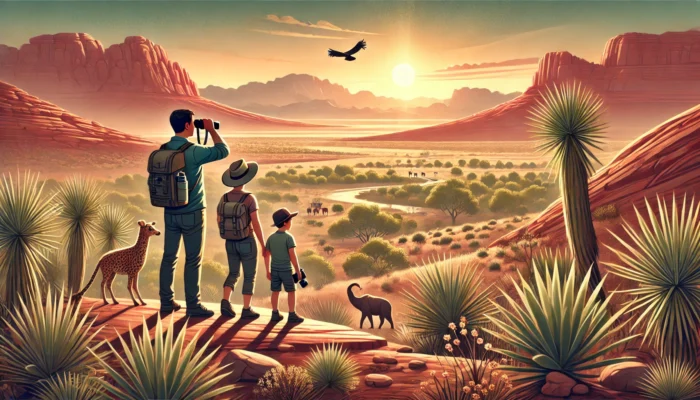
Plan Ahead
- Research Locations – Different areas attract different species. Plan your trip based on the type of wildlife you’re hoping to see.
- Check the Weather – Extreme heat can drive animals into hiding. Choose cooler days or visit during early morning or evening.
- Know the Seasons – Migration, breeding, and hibernation cycles influence wildlife visibility. Refer to seasonal guides for the best timing.
Stay Quiet and Patient
- Move Slowly – Sudden movements can scare animals away. Walk calmly and avoid loud noises.
- Be Observant – Look for signs like tracks, scat, or disturbed vegetation. Animals are often nearby even if not immediately visible.
- Blend In – Wear neutral, earth-toned clothing to avoid standing out in the environment.
Bring the Right Gear
- Binoculars – Essential for spotting animals from a distance.
- Camera with Zoom Lens – Capture wildlife without intruding on their space.
- Water and Snacks – Stay hydrated, especially during desert excursions.
- Sun Protection – Hats, sunscreen, and light clothing protect against intense desert sun.
Respect Wildlife and Nature
- Keep Your Distance – Use binoculars or zoom lenses to observe animals from afar. Never approach or feed wildlife.
- Stick to Trails – This helps preserve fragile habitats and prevents unintentional harm to wildlife.
- Leave No Trace – Pack out all trash and leave natural areas as you found them.
Visit During Optimal Times
- Dawn and Dusk – Many animals are crepuscular, meaning they are most active during the early morning or late evening.
- After Rainfall – Wildlife is often more active after a rare desert rain.
Wild Nevada: Discover the Wildlife Beyond the Strip
While Las Vegas dazzles with its bright lights and entertainment, the surrounding desert landscapes, wetlands, and mountain ranges offer an equally mesmerizing experience for nature lovers. From the iconic bighorn sheep of Red Rock Canyon to the vibrant migratory birds at Wetlands Park, the region boasts an incredible array of wildlife waiting to be discovered.
By venturing just a short distance from the city, visitors can experience the rich biodiversity that thrives in Nevada’s deserts and forests. Whether you’re hiking at Mount Charleston, exploring ancient petroglyphs in Sloan Canyon, or quietly observing bald eagles near Lake Mead, these adventures provide a deeper connection to the land and its natural inhabitants.
For families, photographers, and outdoor enthusiasts alike, the best places to spot wildlife near Las Vegas offer a refreshing escape and a reminder that nature’s wonders are never far away. With careful planning, respect for the environment, and an appreciation for the creatures that call this region home, every wildlife adventure can become a memorable part of your Las Vegas experience.



